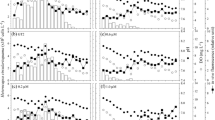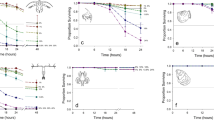Abstract
In order to evaluate the potential to control the fish-killing dinoflagellate Cochlodinium polykrikoides, we compared the algicidal effects of the thiazolidinedione derivative TD49 with those of yellow clay in 10-L microcosms. The responses of higher trophic level marine organisms and microbial loop communities to the algicide were also evaluated. In the yellow clay treatments, the concentration of C. polykrikoides was slightly reduced at day 1 of the experiment but remained higher than that of the control, suggesting that the reduction ratio of C. polykrikoides was <20 %. In the 0.8-μM TD49 treatment, the abundance of C. polykrikoides declined by 98 % 1 day following the addition of the algicide. The algicide did not affect nontarget algae including Chaetoceros spp., Skeletonema spp., Cylindrotheca spp., and other species. In all microcosms, bacterial abundance increased abruptly after day 1, then declined over the next 2 days as a result of predation by heterotrophic nanoflagellates and the small protozoan Uronema sp. Predation by the large protozoan species Euplotes sp. on Uronema sp. gradually increased with increasing incubation time in the TD49 treatment. Zooplankton were particularly affected by the environmental changes that occurred in the microcosms following collapse of the C. polykrikoides populations. Striped beak perch were not affected by the yellow clay treatments and concentrations of TD49 < 2.0 μM. The results suggested that the yellow clay has little effect on C. polykrikoides, whereas the algicide TD49 is effective in controlling the harmful alga. The results imply that the algicide has positive effects on natural microbial communities and is not toxic to nonharmful algae and higher trophic level marine organisms.







Similar content being viewed by others
References
Anderson DM (2009) Approaches to monitoring, control and management of harmful algal blooms (HABs). Ocean Coast Manage 52:342–347
Baek SH, Hong SS, Song SY, Lee HO, Nakano SI, Han MS (2009) Grazing effects on toxic and non-toxic Microcystis aeruginosa by the mixotrophic flagellate Ochromonas sp. J Freshw Ecol 24:367–373
Baek SH, Jang MC, Son MH, Joo HM, Cho H, Kim YO (2012) Algicidal effects of a newly developed thiazolidinedione derivative TD49, on dinoflagellate Akashiwo sanguinea. Ocean Polar Res 34:1–11 (In Korean)
Baek SH, Jang MC, Son M, Kim SW, Cho H, Kim YO (2013a) Algicidal effects on Heterosigma akashiwo and Chattonella marina (Raphidophyceae), and toxic effects on natural plankton assemblages by a thiazolidinedione derivative TD49 in a microcosm. J Appl Phycol 25:1055–1064
Baek SH, Son M, Bae SW, Shin K, Na DH, Cho H, Yamaguchi M, Kim YO, Kim SW (2013b) Algicidal activity of the thiazolidinedione derivative TD49 against the harmful dinoflagellate Heterocapsa circularisquama in a mesocosm enclosure. J Appl Phycol 25:1555–1565
Baek SH, Son M, Shim WJ (2013c) Effect of chemically enhanced water-accommodated fraction of Iranian heavy crude oil on periphytic microbial communities in microcosm experiment. Bull Environ Contam Toxicol 90:605–610
Baek SH, Son M, Jung SW, Na DH, Cho H, Yamaguchi M, Kim SW, Kim YO (2014) Enhanced species-specific chemical control of harmful and non-harmful algal bloom species by the thiazolidinedione derivative TD49. J Appl Phycol 26:311–321
Caron DA (1983) Technique for enumeration of heterotrophic and phototrophic nanoplankton, using epifluorescence microscopy, and comparison with other procedure. Appl Environ Microbiol 46:491–498
Choi HG, Kim PJ, Lee WC, Yun SJ, Kim HG, Lee HJ (1998) Removal efficiency of Cochlodinium polykrikoides by yellow loess. J Korean Fish Soc 31:109–113 (In Korean)
Fenchel T (1982) Ecology of heterotrophic microflagellates. IV. Quantitative occurrence and importance as bacterial consumers. Mar Ecol Prog Ser 9:35–42
Fujii S, Heron ML, Kim K, Lai JW, Lee SH, Wu X, Wu X, Wyatt LR, Yang WC (2013) An overview of developments and applications of oceanographic radar networks in Asia and Oceania countries. Ocean Sci J 48:69–97
Imai I, Ishida Y, Hata Y (1993) Killing of marine phytoplankton by a gliding bacterium Cytophaga sp., isolated from the coastal sea of Japan. Mar Biol 116:527–532
Jeong JH, Jin HJ, Sohn CH, Suh KH, Hong YK (2000) Algicidal activity of the seaweed Corallina pilulifera against red tide microalgae. J Appl Phycol 12:37–43
Jeong S-Y, Ishida K, Ito Y, Okada S, Murakami M (2003) Bacillamide, a novel algicide from the marine bacterium, Bacillus sp. SY-1, against the harmful dinoflagellate, Cochlodinium polykrikoides. Tetrahedron Lett 44:8005–8007
Jeong HJ, Yoo YD, Kim JS, Seong KA, Kang NS, Kim TH (2010) Growth, feeding and ecological roles of the mixotrophic and heterotrophic dinoflagellates in marine planktonic food webs. Ocean Sci J 45:65–91
Kamiyama T, Itakura S, Nagasaki K (2000) Changes in microbial loop components: effects of a harmful algal bloom formation and its decay. Aquat Microb Ecol 21:21–30
Kim HG (1987) Ecology study of dinoflagellate responsible for red tide. 1. The population growth and control of Prorocentrum triestinum Schiller. Bulletin NFRDI 39:1–6
Kim HG (2006) Mitigation and controls of HABs. In: Grane’li E, Turner JT (eds) Ecology of harmful algae. Springer, Berlin, pp 327–338
Kim CS, Lee SG, Lee CK, Kim HG, Jung J (1999) Reactive oxygen species as causative agents in the ichthyotoxicity of the red tide dinoflagellate Cochlodinium polykrikoides. J Plankton Res 21:2105–2155
Kim CS, Bae HM, Cho YC (2001) Control of harmful algal blooms by clay via photochemical reaction. Algae 16:67–73
Kim JS, Kim JC, Lee S, Lee BH, Cho KY (2006) Biological activity of L-2-azetidinecarboxylic acid, isolated from Polygonatum odoratum var. pluriflorum, against several algae. Aquatic Botany 85:1–6
Kim YM, Wu Y, Duong TU, Ghodake GS, Kim SW, Jin ES, Cho H (2010) Thiazolidinediones as a novel class of algicides against red tide harmful algal species. Appl Biochem Biotechnol 162:2273–2283
Kim YM, Wu Y, Duong TU, Jung SG, Kim SW, Cho H, Jin ES (2012a) Algicidal activity of thiazolidinediones derivatives against harmful algal blooming species. Mar Biotechnol 14:312–322
Kim YO, Shin K, Jang PG, Choi HW, Noh JH, Yang EJ, Kim E, Jeon D (2012b) Tintinnid species as biological indicators for monitoring intrusion of the warm oceanic waters into Korean coastal waters. Ocean Sci J 47:161–172
Lee YJ, Choi J-K, Kim EK, Youn S-H, Yang EJ (2008) Field experiments on mitigation of harmful algal blooms using a sophorolipid-yellow clay mixture and effects on marine plankton. Harmful Algae 7:154–162
Lee CK, Park TG, Park YT, Lim WA (2013) Monitoring and trends in harmful algal blooms and red tides in Korean coastal waters, with emphasis on Cochlodinium polykrikoides. Harmful Algae 30S:S3–S14
Lehman JM, Moore LB, Smith-Oliver TA, Wilkinson WO, Willson TM, Kliewer SA (1995) An antidiabetic thiazolidinedione is a high affinity ligand for peroxisome proliferator-activated receptor (PPAR). J Biol Chem 270:12953–12956
Li FM, Hu HY (2005) Isolation and characterization of a novel antialgal allelochemical from Phragmites communis. Appl Environ Microb 71:6545–6553
Liu J, Zhang H, Yang W, Gao J, Ke Q (2004) Studies on biquaternary ammonium salt algaecide for removing red tide. Mar Sci Bull 6:60–65
Margalef R (1961) Hidrografia y fitoplancton de un area marina de la costa meridional de Puerto Rico. Invest Pesq 18:76–78
Na GH, Choi WJ, Chun YY (1996) A study on red tide control with loess suspension. Korean J Aquacult 9:239–245
Nagasaki K, Tomaru Y, Tarutani K, Katanozaka N, Yamanaka S, Tanabe H, Yamaguchi M (2003) Growth characteristics and intraspecies host specificity of a large virus infecting the dinoflagellate Heterocapsa circularisquama. Appl Environ Microbiol 69:2580–2586
Nakamura Y, Fukami K, Sasaki S, Hiromi J (1994) Population dynamics of bacteria and heterotrophic nanoflagellates following the summer diatom bloom in the Seto Inland Sea. Bull Plankton Soc Jpn 41:1–8
NFRDI (2013) Monitoring, management and mitigation of red tide. Annual report of NFRDI on red tide of Korea, Busan, Korea (in Korean) http://nfrdi.re.kr/redtideInfo
Park TG, Lim WA, Park YT, Lee CK, Jeong HJ (2013) Economic impact, management and mitigation of red tides in Korea. Harmful Algae 30S:S131–S143
Porter KG, Feig YS (1980) The use of DAPI for identification and counting aquatic microflora. Limnol Oceanogr 25:943–948
Schrader KK, Nanayakkara NPD, Tucker CS, Rimando AM, Ganzera M, Schaneberg BT (2003) Novel derivatives of 9,10-anthraquinone are selective algicides against the musty-odor cyanobacterium Oscillatoria perornata. Appl Environ Microb 69:5319–5327
Sengco MR, Anderson DM (2004) Controlling harmful algal blooms through clay flocculation. J Eukaryot Microbiol 51:169–172
Shirota A (1989) Red tide problem and countermeasures. Int J Aquat Fish Technol 1:195–293
Shirota A, Adachi M (1976) Annual meeting of Japan Oceanogr Soc, p 15
Shumway SE, Frank DM, Ewart LM, Ward JE (2003) Effect of yellow loess on clearance rate in seven species of benthic, filter-feeding invertebrates. Aquacult Res 34:1391–1402
Sigee DC, Glenn R, Andrews MJ, Bellinger EG, Butler RD, Epton HAS, Hendry RD (1999) Biological control of cyanobacteria: principle and possibilities. Hydrobiologia 395(396):161–172
Tanaka T, Taniguchi A (1999) Predator-prey eddy in heterotrophic nanoflagellate-bacteria relationships in a bay on the northeastern Pacific coast of Japan. Mar Ecol Prog Ser 179:123–134
Terlizzi DE, Ferrier MD, Armbrester EA, Anlauf KA (2002) Inhibition of dinoflagellate growth by extracts of barley straw (Hordeum vulgare). J Appl Phycol 14:275–280
Yamatogi T, Maruta H, Ura K (2002) Occurrence of Cochlodinium polykrikoides red tide and its growth characteristics in Imari Bay in 1999. Bull Nagasaki Prefectural Inst Fish 28:21–22
Yu ZM, Zou JZ, Ma X (1994) Application of clays to removal of red tide organisms 1. Coagulation of red tide organisms with clays. Chin J Oceanol Limnol 12:193–200
Yuki K, Yoshimatsu S (1989) Two fish-killing species of Cochodinium from Harima-Nada, Seto Inland Sea, Japan. In: Okaichi T, Anderson DM, Nemoto T (eds) Red tides: biology, environmental science and toxicology. Elsevier, New York, pp 451–454
Acknowledgments
This research was supported by the Pioneer Research Center Program through the National Research Program of Korea, funded by the Ministry of Education, Science and Technology (grant no. M1071118001-08 M1118-00110) and KIOST projects (PE99191).
Author information
Authors and Affiliations
Corresponding authors
Rights and permissions
About this article
Cite this article
Baek, S.H., Shin, K., Son, M. et al. Algicidal effects of yellow clay and the thiazolidinedione derivative TD49 on the fish-killing dinoflagellate Cochlodinium polykrikoides in microcosm experiments. J Appl Phycol 26, 2367–2378 (2014). https://doi.org/10.1007/s10811-014-0275-9
Received:
Revised:
Accepted:
Published:
Issue Date:
DOI: https://doi.org/10.1007/s10811-014-0275-9




